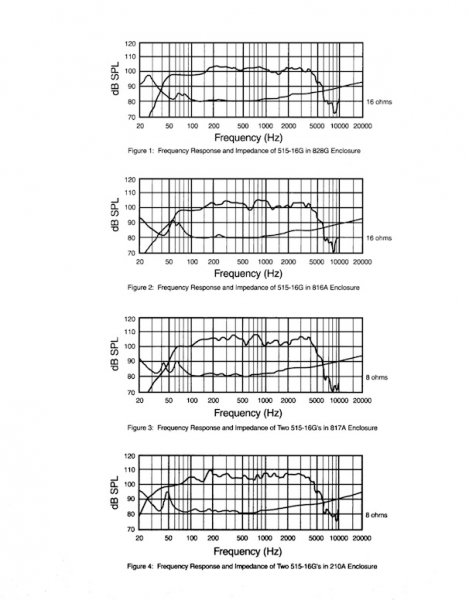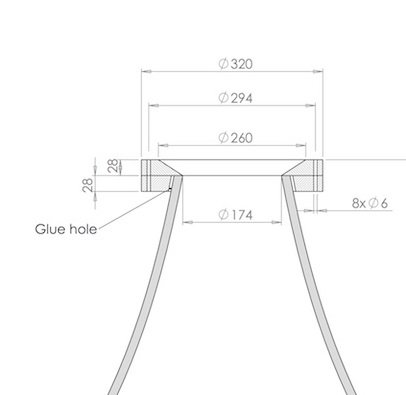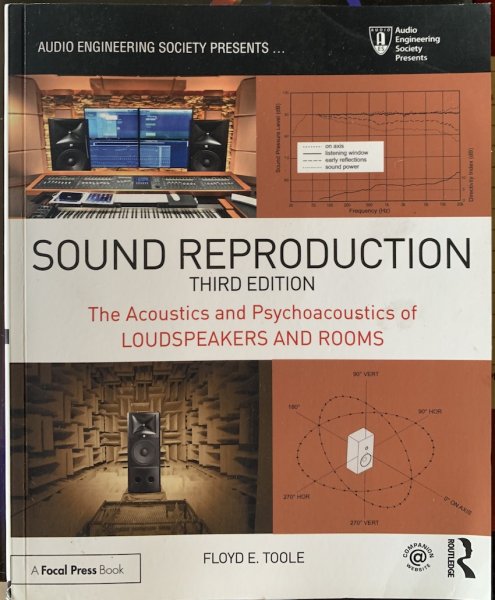Zero Distortion: Altec Assault and the Magic of Misho (Audio Antiquary)
- Thread starter bonzo75
- Start date
You are using an out of date browser. It may not display this or other websites correctly.
You should upgrade or use an alternative browser.
You should upgrade or use an alternative browser.
Where did you get 9.5 from?
That’s the min length for 30hz to be affectively effected by a horn. Below that it’s not a horn, 30hz goes back into omnidirectional. You get it by dividing the sound wavelength by 4.
However a lot of horns are longer than 1/4 of the wavelength which can make them more directional, higher sensitivity.
Also horn loading for 80hz FLH starts at 3.5ft, so midbass is perfectly possible with a bit box, like some I suspect Ked has posted.
I suspect most of the 'normal' sized 'mid bass' flh transition from controlled directivity to omni well before their LF crossover point. I think the argument for u / h frame open baffle subs makes sense here.
In any case controlled directivity speakers pushing into low bass territory are not known to be 'easy' to get right ( huge horn systems or danley type for example)
Is this an example of early audio scientists stumbling onto a good topology or did they know more
In any case controlled directivity speakers pushing into low bass territory are not known to be 'easy' to get right ( huge horn systems or danley type for example)
Is this an example of early audio scientists stumbling onto a good topology or did they know more
First lets sort out the mystery of Altec horn loading midbass with measurements;
828G loads around 180hz
816A about 180hz as well
dual 515's in 817 loads around 120-140hz
dual 515's in 210a again loads around 180hz

These are roughly where there is actually horn loading. Altecs use horn, direct radiator and bass reflex all at the same time in some of them.
Also, please also note not all horn loading is the same. As you can see from the examples some short horns are seemingly loading as low as my large horn. Please check the efficiency gain. Having those large throats does not let you load like you would like. Although I have an 12" driver, I do not have 12" throat.
828G loads around 180hz
816A about 180hz as well
dual 515's in 817 loads around 120-140hz
dual 515's in 210a again loads around 180hz

These are roughly where there is actually horn loading. Altecs use horn, direct radiator and bass reflex all at the same time in some of them.
Also, please also note not all horn loading is the same. As you can see from the examples some short horns are seemingly loading as low as my large horn. Please check the efficiency gain. Having those large throats does not let you load like you would like. Although I have an 12" driver, I do not have 12" throat.
Here is the detail for my mid-bass throat
If you are interested in horns at all, please buy and read;
High Quality Horn Loudspeaker Systems
by Bjørn Kolbrek and Thomas Dunker
https://www.lean-business.co.uk/esh...-bjørn-kolbrek-and-thomas-dunker-p-3317.html
If you are interested in horns at all, please buy and read;
High Quality Horn Loudspeaker Systems
by Bjørn Kolbrek and Thomas Dunker
https://www.lean-business.co.uk/esh...-bjørn-kolbrek-and-thomas-dunker-p-3317.html
Attachments
First lets sort out the mystery of Altec horn loading midbass with measurements;
828G loads around 180hz
816A about 180hz as well
dual 515's in 817 loads around 120-140hz
dual 515's in 210a again loads around 180hz
View attachment 64061
These are roughly where there is actually horn loading. Altecs use horn, direct radiator and bass reflex all at the same time in some of them.
Also, please also note not all horn loading is the same. As you can see from the examples some short horns are seemingly loading as low as my large horn. Please check the efficiency gain. Having those large throats does not let you load like you would like. Although I have an 12" driver, I do not have 12" throat.
So figure 3 is showing 100 db at 100 Hz?
Yes, it does but there is no horn gain there.So figure 3 is showing 100 db at 100 Hz?
Yes, it does but there is no horn gain there.
Where is the horn gain stopping
Where is the horn gain stopping
I have written that and also attached the measurements! You can even see port tuning frequencies, there is impedance along the spl...
From figure 3, what I am seeing is, the top line (horn cabinet) is averaging around 105 db and going down to 100 db at 100Hz, and flatlining at 100 db till 60ish Hz, after which it drops off (must be the Fc of the horn).
You can never turn the vents off, shown on the bottom line, and they must be contributing, but they take over alone (no horn) towards the bottom and are giving 90db at 20Hz, as per the graph.
You can never turn the vents off, shown on the bottom line, and they must be contributing, but they take over alone (no horn) towards the bottom and are giving 90db at 20Hz, as per the graph.
Last edited:
From figure 3, what I am seeing is, the top line (horn cabinet) is averaging around 105 db and going down to 100 db at 100Hz, and flatlining at 100 db till 60ish Hz, after which it drops off (must be the Fc of the horn).
You can never turn the vents off, shown on the bottom line, and they must be contributing, but they take over alone (no horn) towards the bottom and are giving 90db at 20Hz, as per the graph.
You can see the rising responses, showing where horn provides the gain. If you just read the numbers I wrote and correlate them, it may have been easy to see, maybe I could not explain myself.
For ex. the figure 3, you can see the rising response from 100hz where horn loading starts and loads fully at about 140hz. This is horn loaded from about 140hz.
You can also find the tuning of the port out of the impedance graphics. It resides in the low point between the two peaks. Sealed has one peak, vented has two peaks. In a very basic sense, the low peak is related to the vent and the higher one is mostly about the damping of the box. So figure 3 seems to have port tuning frequency around 50hz.
Dear Ked, you are serious about sound reproduction maybe it is time to read on some theory to have a foundation and correlate what you hear to what is going on. You have listened to a lot of hifi equipment, I hope you also visit some music studio control rooms and meet engineers to have a balanced view. The way to a great start could be reading this book;
Attachments
You've probably seen this, but was looking at subs and saw that Funk Audio custom makes these dual 15" FLHs and thought you might be interested...From figure 3, what I am seeing is, the top line (horn cabinet) is averaging around 105 db and going down to 100 db at 100Hz, and flatlining at 100 db till 60ish Hz, after which it drops off (must be the Fc of the horn).
You can never turn the vents off, shown on the bottom line, and they must be contributing, but they take over alone (no horn) towards the bottom and are giving 90db at 20Hz, as per the graph.
https://www.funkaudio.ca/store/p46/15.H_Horn_subwoofer_Custom_order.html
You've probably seen this, but was looking at subs and saw that Funk Audio custom makes these dual 15" FLHs and thought you might be interested...
https://www.funkaudio.ca/store/p46/15.H_Horn_subwoofer_Custom_order.html
Thanks. Just to clarify the 15 inch dual woofer front loaded horns I was writing about are for Midbass. These are for the next level down. this is one 15 for the lower bass. Leif has made himself one 21 inch. There are other solutions as well including the open baffle type multiwoofer with a slit in the middle of the plane that Western electric had demoed at Munich last year. But all those require space.
Got it. Would you also consider dual FLH for low bass?Thanks. Just to clarify the 15 inch dual woofer front loaded horns I was writing about are for Midbass. These are for the next level down. this is one 15 for the lower bass. Leif has made himself one 21 inch. There are other solutions as well including the open baffle type multiwoofer with a slit in the middle of the plane that Western electric had demoed at Munich last year. But all those require space.
Got it. Would you also consider dual FLH for low bass?
It is not as important to me. I don't think I am adamant on a type of solution there. It should roll over properly from the Midbass horn, and give sufficient weight, ambience, detail. I have heard good Midbass with a big front loaded horn, sealed subs, and there are also cheap horn loaded DIY alternatives the size of a small fridge to be kept in the corner. All could work.
Thanks. Good to know.It is not as important to me. I don't think I am adamant on a type of solution there. It should roll over properly from the Midbass horn, and give sufficient weight, ambience, detail. I have heard good Midbass with a big front loaded horn, sealed subs, and there are also cheap horn loaded DIY alternatives the size of a small fridge to be kept in the corner. All could work.
Thanks. Good to know.
The main thing for me is the dual woofer FLH for the Midbass. That is what integrates the speaker and is the Achilles heel of most, in fact nearly all speakers. The upper mids, highs, and lower bass can be managed to preferences. Want density and roll off? Easy. Want clean extended highs? Equally easy. And so on.
Will bear that in mind.The main thing for me is the dual woofer FLH for the Midbass. That is what integrates the speaker and is the Achilles heel of most, in fact nearly all speakers. The upper mids, highs, and lower bass can be managed to preferences. Want density and roll off? Easy. Want clean extended highs? Equally easy. And so on.
The main thing for me is the dual woofer FLH for the Midbass. That is what integrates the speaker and is the Achilles heel of most, in fact nearly all speakers. The upper mids, highs, and lower bass can be managed to preferences. Want density and roll off? Easy. Want clean extended highs? Equally easy. And so on.
Very interesting comment, some speaker designers such as Troels Gravesen say that it takes quite a lot of surface area to achieve a full bodied, real sounding pair of speakers. IE: he uses 8' midranges down to 160hz + 15' woofer, 6.5' midranges never lower than 200hz, you get the point. Maybe is the huge surface area + high efficiency what makes the sound compelling and not the partial horn loading? With a huge Onken style cabinet and the right drivers (ie: 15' Supravox 400 EXC field coil or AE TD18H) and some room gain it should be possible to achieve a sensitivity around 100db, and you wouldn't need subs.
Btw this is just a random thought, I'm not knocking down the FLH, just regurgitating some ideas, of course the FLH would be more even more efficient, but would take some serious real state compared to the already huge (around 400l cabinet) Onken style speakers.
Last edited:
Staff online
-
treitz3Super Moderator
Members online
- Wavetouch
- Opabin
- rangda
- Chauncey79
- Kjetil
- treitz3
- Azjya
- ticktock
- RSB
- redscouser
- justubes
- lscangus
- gleeds
- nkbg
- LR319
- Ron Resnick
- Whbgarrett
- Dbattista
- Mike Lavigne
- DennisH
- Three quid
- CraigS
- blackswan
- hopkins
- Stef
- TLi
- nattonrice
- SeungHo Choi
- Pokey77
- Audio Addict
- turbinetodd
- lordcloud
- J007B
- Nooshinjohn
- Roger
- Scatterbrain99
- rau
- bonzo75
- RyanTX
- agrinfeld
- AudioLibertarian
- pweg
- rsorren1
- the sound of Tao
- Long Live Analog
- Sharok
- JimmyS
- MPW
- XV-1
- Downtheline
Total: 902 (members: 58, guests: 844)
| Steve Williams Site Founder | Site Owner | Administrator | Ron Resnick Site Co-Owner | Administrator | Julian (The Fixer) Website Build | Marketing Managersing |


















